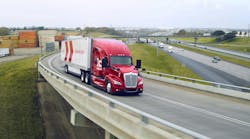The highway and road networks in this country are in dire need of a makeover, as well as big additions in capacity. The problem is, at the same moment we come to the overdue conclusion that such investments are necessary, it's becoming more costly to fund them.
“Red-hot steel prices, combined with record diesel fuel costs, are making construction unaffordable,” Ken Simonson, chief economist for the Associated General Contractors of America (AGC), said in a recent analysis.
“The PPI [producer price index] for inputs to construction industries — materials used in all types of construction plus items consumed by contractors, such as diesel fuel — soared 2.1% in March alone,” he noted. “That jump was propelled by a staggering 24% increase in diesel fuel costs and a 5.5% rise in prices for steel mill products.”
All this at a time when the Highway Trust Fund is going broke. More than half of U.S. urban interstates are now congested, according to research compiled by the HNTB Companies, and it's projected that next year, federal Highway Trust Fund revenues will no longer be sufficient to fully fund federal transportation spending.
Also, according to the National Surface Transportation Policy and Revenue Study Commission's report, published earlier this year, all levels of government in the U.S. are spending less than 40% of the $225 billion to $340 billion needed for highway upkeep.
Legislation was introduced in the U.S. Senate to create an agency and a National Infrastructure Bank to facilitate and fund large federal projects, with a preference for those that leverage private financing and public/private partnerships. Problem is, with costs spiraling upwards, federal dollars won't go nearly as far as they used to.
“Public agencies as well as private owners need to adjust to these realities,” said AGC's Simonson. “Too many of them are still assuming construction costs are rising no faster than the consumer price index [CPI], when in fact the PPI for construction inputs has gone up 6.5% in the past 12 months and 34% since steel prices first surged in December 2003. That is more than double the run-up in the CPI.”
He added that higher diesel prices are putting a triple burden on contractors. “As the highway paving season gets under way, asphalt prices also are poised to take off,” Simonson concluded. “Asphalt at the refinery cost 13% more in March than a year ago.”
Yet we need to improve and expand our infrastructure — and we need to do it now. “Without an adequate transportation system, the nation's economic growth is at risk,” said Janet Kavinoky, executive director, Americans for Transportation Mobility (ATM) coalition, in a recent report entitled “The Transportation Challenge: Moving the U.S. Economy,” published by ATM and the National Chamber Foundation of the U.S. Chamber of Commerce.
“If the U.S. declines to invest in transportation infrastructure and ignores the transportation needs of key industry sectors, our economy will become less productive and less competitive,” she warned.
Kavinoky noted that countries like China are building highways and rail lines, developing ports, and constructing airports while the U.S. transportation system erodes. But without investment in transportation infrastructure here, guided by new policies, the study says our system will fall further behind the growing demand of five major economic sectors — agriculture and natural resources, manufacturing, retail, services, and transportation — that account for 84% of the U.S. economy.
Given population growth, shifting demographics and steady economic growth, a high-performance transportation system is a necessity. “We have only one option: Invest now, or pay later,” said Kavinoky.


